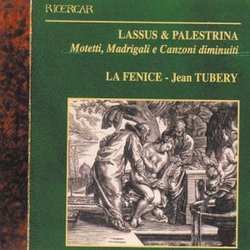| All Artists: Giovanni Battista Bovicelli, Bartolome de Selma y Salaverde, Francesco Rognoni, Christian Erbach, Orlande de Lassus, Giovanni Bassano, Peter [composer] Philips, John Dowland, Emanuel Adriaenssen, Giovanni Antonio Terzi, Ensemble la Fenice, Jean-Marc Aymes Title: Lassus, Palestrina: Motetti, Madrigali e Canzoni diminuiti Members Wishing: 0 Total Copies: 0 Label: Ricercar Release Date: 9/4/2007 Genres: Special Interest, Pop, Classical Styles: Vocal Pop, Opera & Classical Vocal, Chamber Music, Historical Periods, Baroque (c.1600-1750) Number of Discs: 1 SwapaCD Credits: 1 |
Search - Giovanni Battista Bovicelli, Bartolome de Selma y Salaverde, Francesco Rognoni :: Lassus, Palestrina: Motetti, Madrigali e Canzoni diminuiti
 | Giovanni Battista Bovicelli, Bartolome de Selma y Salaverde, Francesco Rognoni Lassus, Palestrina: Motetti, Madrigali e Canzoni diminuiti Genres: Special Interest, Pop, Classical
|
Larger Image |
CD Details |
CD ReviewsFlorid Virtuosity Giordano Bruno | Wherever I am, I am. | 04/17/2008 (4 out of 5 stars) "Pier Luigi de Palestrina and Orlando Lassus died the same year, 1594, and both would be rolling in their marble tombs to hear that anyone supposes this music is theirs. Palestrina in Rome and Lassus in Germany were the supreme old guard of the austere, intellectual polyphony of the Renaissance. Palestrina in particular was esteemed by the purists of the Counterreformation for his simplicity and devotion to the clearest declamation of text. He wrote next to nothing for instruments, not even organ or harpsichord in support of his choral music. So what's going on here?
The fifteen pieces on this CD come chiefly from ornamentation manuals by composers of the next generation - Bovicelli, De Selma, Rognoni, Bassano, and others - who appropriated motets and madrigals by the old masters to be used as examples of their own surperior taste and skill. This, oh listeners, is the precise moment of musical history when the Renaissance morphed into the Baroque, literally writing over the flowing profundity of one with the florid exuberance of the other. Modern listeners often ask how musicologists and performers can talk about authenticity of technique and style when there are of course no recordings of music from the 16th or 17th Centuries. One way to know is to read the manuals! There were instructional books in print for instrumentalists - especially cornettists and viola da gambists - on how to tongue, how to phrase, and especially how to improvise ornamentation. Pages and pages of precise examples of arpeggiated cadences and intervals fill the pages of Ganassi for recorder flutes), Ortiz for gambists, and the current forgottem masters for musicians at large. La Fenice has presented us with a recital of these exercises in taste and virtuosity. Modern ears, I think, will hear more of the latter than the former. These little pieces are as excessive, musically, as the bows and ribbons on an ante-bellum belle's bonnet. But they're a lot of fun, both to play and to hear when played by a world-class virtuoso like Jean Tubery, the heart of La Fenice. Tubery's instruments are the cornetto, the mute cornetto, and the recorder, all of which respond to the player's tongue and fingers flying over 32nd and 64th notes fast enough to make a Pentium 4 computer chip sqeak for help. Tubery's cornetto is not a brass instrument. It's a tapered wooden tube about the size and shape of an antelope horn, with seven finger holes and a tiny cup moutpiece. The cornetto was the show-off virtuoso instrument of the early Baroque, to be heard at its most eloquent in the music of Gabrieli, Monteverdi, and Schuetz. In this performance, Tubery is supported by a harpist, a lutenist, and a keyboardist, all very fine players capable of taking their licks at the fastball ornamental figures. They are joined, unfortunately, on two of the Lassus-based exercises by Francois Fauche, a capable bass singer who just can't turn the trick on these hyper-gymnastic musical figures. Those two tracks cry out to be skipped; that's why I've given the CD only four stars. This isn't great music in itself. It wasn't intended to be performance material at all. But Tubery's playing is so spectacular that any time he picks up his horn, I'm ready to listen." |

 Track Listings (15) - Disc #1
Track Listings (15) - Disc #1